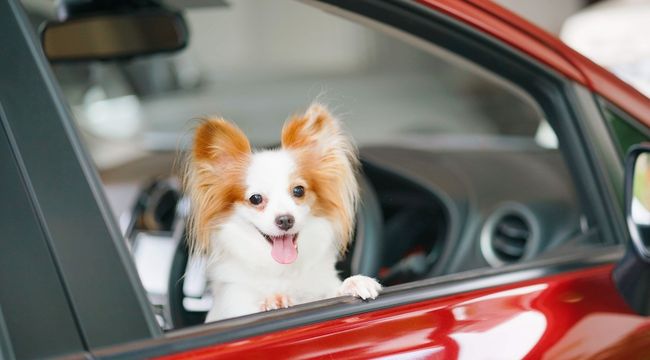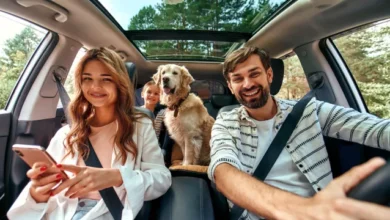
According to the Roanoke Times, 78% of Americans, who have pets, travel with them each year.
But you cannot deny that It’s difficult to travel long distances with your dog. It can be stressful for both of you and make for a less enjoyable trip. However, if done correctly and with some preparation, it can be an exciting adventure instead of a headache.
Here are some tips that will help make your next cross-country car trip easier for both you and your pet.
Bathe Your Dog Before Traveling
The cardinal rule of traveling with a dog is to bathe them before you leave. If you don’t, your furry friend can get sick from exposure to diseases other dogs have picked up or simply get dirty on their own during the trip. You don’t want your dog smelling bad and being itchy or uncomfortable. This can also help prevent allergies for those who are sensitive to animal dander.
Bathing them before leaving will make sure they’re clean and smell good when you start your trip.
Keep Your Dog Properly Seated in the Car
Keeping your dog properly restrained in the car is important for safety and comfort. There are several ways to do this:
- Use a dog seat belt, which will keep your pup safely harnessed on the side of the backseat.
- If you don’t have a dog seat belt, use a harness instead. Make sure it’s fitted correctly with no gaps between the chest piece and the body, making it difficult for them to slip out of their harness during traveling.
- A third option is using a car seat that attaches directly to your vehicle’s seat belt system. This might be more convenient than taking off/putting on harnesses while in motion.
- It also helps that you have a seat cover to protect your rear seats from scratches and dirt. If you’re looking for a car seat cover, choose ones that made from weatherproof material.
Pack Plenty of Water and Food for Your Dog
It’s a good idea to bring enough water and food for your dog to last the trip. The amount of food will depend on how much food your dog eats normally, as well as if he has any health issues that make him need more or less food than normal.
If you’re traveling by car, consider bringing an empty water bottle with you so that you can fill it up at gas stations. This way, there won’t be any question about whether or not your pet has had enough water during his car ride.
Be Prepared for Accidents in the Car
Safely traveling with pets involves being prepared for an accident during your trip. You should always take a first aid kit with you on the road and have your vet’s phone number handy in case an emergency arises.
If you’re traveling with a crate or kennel, make sure it has plenty of air holes so your dog can breathe if there’s an accident and their nose is covered by their crate or kennel.
Make sure to bring some toys or treats too. This will help distract them from any accidents that may occur during the trip.
Bring a Crate or Kennel for Your Dog
Even if your dog is used to traveling by car, he or she must have a safe and cozy spot for rest stops.
Dog crates make handy traveling furniture for a dog. According to Fact.MR, the dog crate furniture market is expected to flourish in the forecast period of 2021 to 2031 because of factors like rising adaptation to animal furniture, rising number of pets, and rising pet humanization.
The crate should be large enough for him or her to stand up, turn around and lie down comfortably. It’s also a good idea to make sure the crate has wheels so that you can easily move it from one place to another while traveling.
When buying your dog’s travel kennel, make sure its door locks from the outside so as not to allow them back out once inside. Also, ensure that there are no sharp edges where food might spill over onto your floorboards during long journeys since these could cause serious injuries if they are not covered properly beforehand.
Invest in Travel Essentials
A seat belt is another travel essential you should consider. You can use it to restrain your dog in the car, making long drives more comfortable for both of you.
A water bowl isn’t just for drinking. It’s also a great way to keep your pup hydrated on long trips. Make sure it’s large enough for him or her to drink from easily and clean up after themselves afterward. If you’re traveling with food, make sure there’s enough room in their bowl, so they don’t spill any while eating.
All these things must be easy to clean up after and won’t take up too much space in your vehicle when not in use. Look around before buying new equipment for this purpose because the pet accessories market has a large option to choose from.
As per PR Newswire, the pet accessory market saw a year-on-year (YOY) growth of 5.70% in 2021 and is expected to see a compound annual growth rate (CAGR) of 6% during 2021 – 2025, with the U.S. being its key market in North America.
Consider Microchipping or Tattooing Your Pet
You can consider microchipping your pet before the trip if you haven’t done it already. Microchipping your pet is the most reliable way to identify and locate your lost dog.
Microchips are small, flat devices that are implanted in your pet’s skin under their shoulder blades. When scanned by a dog-friendly scanner, they will provide their unique identification number to be used to locate you and reunite you with your canine companion.
Tattoos can fade over time or get rubbed off during playtime with other animals, so it’s important not to rely on this method alone when microchips are available at such low costs these days (usually somewhere between $10-20).
Conclusion
We hope this article has given you some great ideas for traveling with your dog. Remember that every family is different, and there may be things we haven’t covered here that work better for you.
The important thing is to find the best option that works for both of you.



